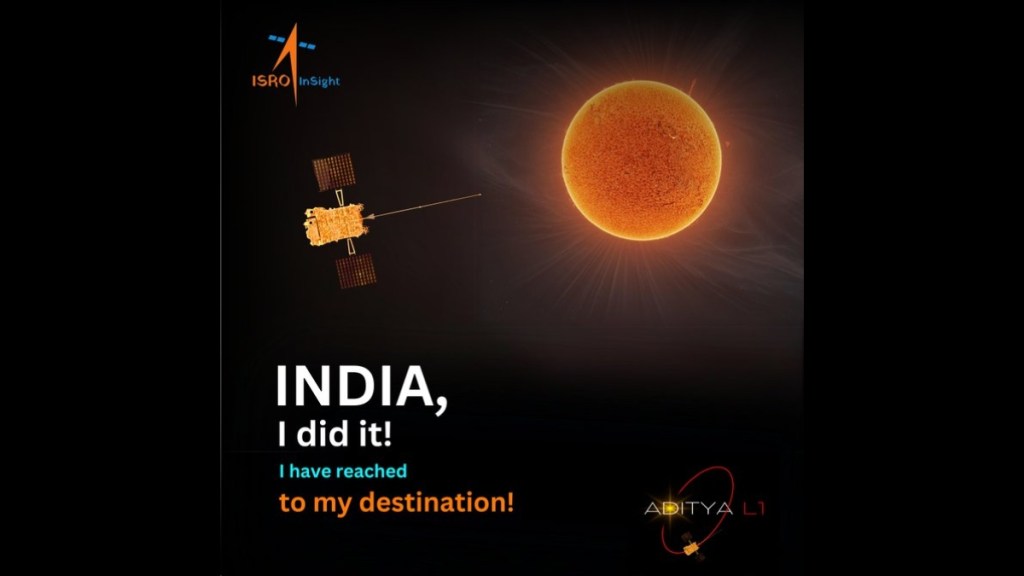The Indian Space Research Organsation (ISRO) has done it again. India’s first solar observatory Aditya-L1 has successfully entered the Halo orbit around the L1 point.
Prime Minister Narendra Modi on Saturday announced that Aditya-L1 has reached its destination, adding that India has created yet another landmark. “India’s first solar observatory Aditya-L1 reaches it destination. It is a testament to the relentless dedication of our scientists in realising among the most complex and intricate space missions,” the Prime Minister said on X.
Aditya-L1 is India’s first space-based observatory designed to study the Sun, and this manoeuvre is a crucial step in the mission’s journey to observe and understand solar activities in real time.
The spacecraft has been strategically placed in a halo orbit around Lagrange point 1 (L1) of the Sun-Earth system, located approximately 1.5 million kilometers from Earth. This point is a mere one percent of the total distance between Earth and the Sun, offering a unique vantage point for continuous observation of the Sun without interruptions from eclipses or occultations.
This manoeuvre is essential to bind Aditya-L1 to its designated halo orbit around L1. Without this precise adjustment, there is a risk that the spacecraft could veer off its intended course, potentially moving toward the Sun.
Why did ISRO choose halo orbit?
The decision to place Aditya-L1 in a halo orbit holds significant advantages for solar observation. Continuous visibility of the Sun from this orbit provides researchers with an unprecedented opportunity to monitor solar activities, such as flares and coronal mass ejections, in real time. This data is crucial for advancing our understanding of space weather and its impact on various phenomena.
All about Aditya-L1 spacecraft
The Aditya-L1 spacecraft, carried into space by the Polar Satellite Launch Vehicle (PSLV-C57), embarked on its journey from the second launch pad of the Satish Dhawan Space Centre (SDSC) in Sriharikota on September 2 of the previous year. Following a flight duration of precisely 63 minutes and 20 seconds, the spacecraft achieved successful injection into an elliptical orbit measuring 235×19500 km around the Earth.
Subsequently, the spacecraft executed a series of maneuvers, directing itself toward Sun-Earth Lagrange Point 1 (L1) after escaping the gravitational influence of Earth. Aditya-L1 is equipped with seven specialized payloads, incorporating electromagnetic, particle, and magnetic field detectors. These payloads are designed for observing various layers of the Sun, including the photosphere, chromosphere, and the outermost region known as the corona.
What are the objectives of Aditya-L1 mission?
The major science objectives of the Aditya-L1 mission are –
- Study of the Solar upper atmospheric (chromosphere and corona) dynamics.
- Study of chromospheric and coronal heating, physics of the partially ionized plasma, initiation of the coronal mass ejections, and flares.
- Observe the in-situ particle and plasma environment, providing data for the study of particle dynamics from the Sun.
- Physics of the solar corona and its heating mechanism.
- Diagnostics of the coronal and coronal loops plasma: Temperature, velocity and density.
- Development, dynamics and origin of coronal mass ejections (CMEs).
- Identify the sequence of processes that occur at multiple layers (chromosphere, base and extended corona) which eventually leads to solar eruptive events.
- Magnetic field topology and magnetic field measurements in the solar corona.
- Drivers for space weather (origin, composition and dynamics of solar wind).
(With agency inputs)
